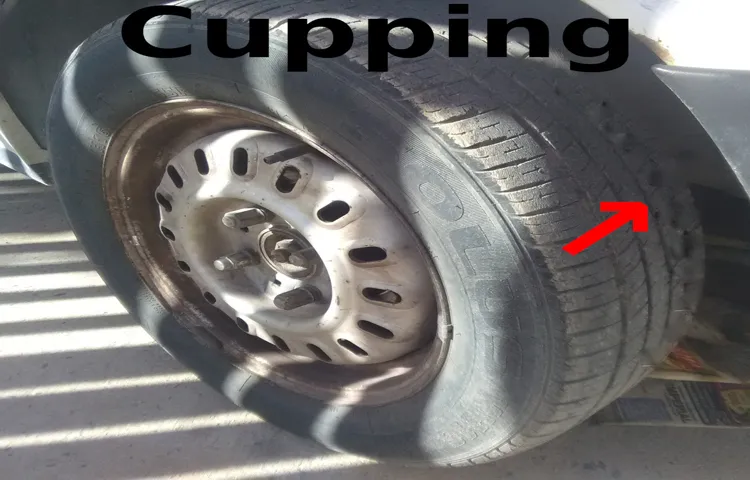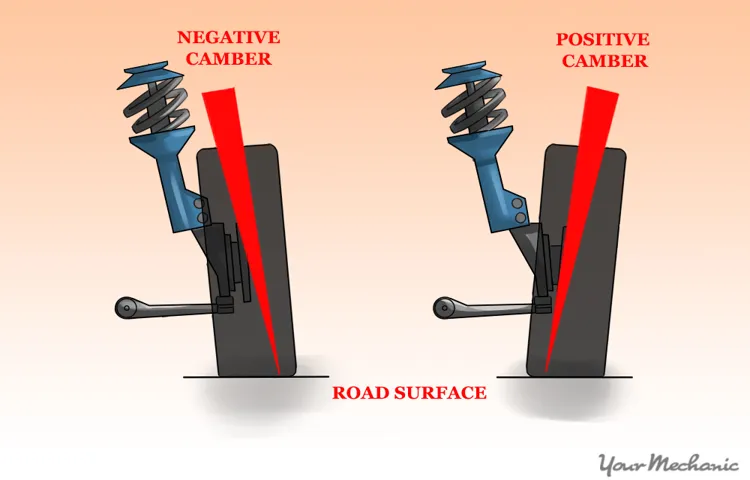Ever noticed that your car’s tire is slanted inward? This is a common sight on many vehicles, and it can be caused by various reasons. A tilted inward tire can be an issue for a number of reasons, such as reduced stability, uneven wear and tear, and other prominent issues. But why does this happen in the first place, and what can be done about it? In this blog post, we’ll dive into the reasons behind a tilted inward tire and discuss what you can do to fix the issue and get your car back to optimal performance.
Table of Contents
Possible Causes
If you notice that your tire is tilted inward, there could be a few possible causes. One of the most common reasons is a worn-out control arm bushing. This component connects the car’s frame to the steering knuckle and helps control the car’s steering.
If it’s worn-out, it may cause the tire to tilt inward, resulting in poor handling and uneven tire wear. Another possible cause is a damaged ball joint. The ball joint connects the steering knuckle to the control arms and allows for smooth wheel movement.
If it’s damaged, it may cause the tire to tilt inward, making the car harder to steer and control. Lastly, an accident or hitting a curb can also cause a tire to tilt inward. If you suspect any of these issues, it’s best to take your vehicle to a trusted mechanic for inspection and repairs.
Remember, it’s crucial to address these problems promptly to ensure your safety on the road.
Worn Ball Joints
Worn ball joints are a common issue that drivers face with their vehicles. Some of the possible causes of worn ball joints include age, usage, and poor road conditions. As vehicles age and are used more frequently, the ball joints experience more wear and tear which can cause them to eventually fail.
Additionally, ball joints can become damaged if they are exposed to harsh driving conditions such as rough roads, potholes, and uneven surfaces. It is important to have your ball joints inspected regularly to avoid potential issues and ensure the safety of your vehicle. If they are found to be worn, it is recommended to replace them as soon as possible to prevent any further damage or safety concerns while driving.
Overall, regular maintenance and careful driving can help to prevent worn ball joints and ensure the longevity of your vehicle.

Damaged Control Arm
If you’re experiencing a damaged control arm, there are a few possible causes that could be behind the issue. One common cause is wear and tear over time, as control arms are designed to bear the weight and stress of the vehicle’s suspension system. This can eventually cause the arm to crack or break entirely.
Another possible cause is damage from a collision or accident, which can bend or warp the arm and affect its ability to function properly. It’s also possible that the control arm wasn’t installed correctly, which can cause it to wear down and fail prematurely. Whether your control arm damage is due to wear and tear, a collision, or installation issues, it’s important to get it fixed as soon as possible to avoid further damage to your suspension system and ensure safe driving.
Bad Wheel Bearings
Bad wheel bearings can be frustrating and dangerous, causing vibrations, odd noises, and potentially compromising your steering abilities. Several factors can contribute to causing bad wheel bearings, including excessive wear and tear, lack of maintenance, or poor installation. Driving habits and environmental conditions can also play a role in causing bearings to wear out more quickly.
If you frequently drive on rough terrain, hit potholes or curbs, or frequently tow heavy loads, your wheel bearings may wear out faster. Moreover, driving in extreme weather conditions like steep mountains, extreme heat, or cold, rainy, or snowy areas can contribute to wear and tear of the bearings. Additionally, poor quality parts and improper installation can result in premature bearing failure.
Therefore, it is important to have a professional mechanic inspect and maintain your wheel bearings regularly to prevent further damage, ensure safety, and prolong the life of your vehicle.
Symptoms of a Tilted Tire
If you’ve noticed that one of your tires is tilted inward, it’s likely that you have a problem with your wheel alignment. A tire that tilts inward is known as “negative camber” and can cause a number of symptoms. One of the most noticeable symptoms is uneven tire wear.
When the tire is tilted, it is not making full contact with the road, which can cause the tire to wear more on one side than the other. Over time, this can lead to bald spots on the tire. Another symptom of a tilted tire is poor handling.
When the tire is not making full contact with the road, it can be more difficult to control the vehicle, especially in wet or slippery conditions. Additionally, you may notice that the tire feels “squishy” when you drive, as it is not properly supporting the weight of the vehicle. If you suspect that your tire is tilted, it’s important to have your alignment checked by a mechanic as soon as possible to avoid further damage and maintain your safety on the road.
Uneven Tire Wear
Uneven tire wear can be caused by various issues, one of which is a tilted tire. A tilted tire occurs when the wheel leans inward or outward instead of standing up straight. This can lead to uneven pressure distribution and result in uneven tire wear.
Symptoms of a tilted tire include a vehicle that pulls to one side while driving, excessive vibration in the steering wheel, and uneven tire wear patterns. To prevent tire tilt, regular tire rotations and balancing are recommended. It is also important to address any suspension or alignment issues promptly.
If you notice any symptoms of a tilted tire, it’s best to have it checked by a professional to avoid further damage to your tires and vehicle.
Vehicle Pulls to One Side
If your vehicle is pulling to one side while driving, it could be a sign of a tilted tire. This is a common issue that many drivers face, and it can be caused by a variety of factors. One symptom of a tilted tire is uneven wear on the tread.
This can cause the tire to become worn more on one side than the other, which can cause your vehicle to pull in that direction. Another symptom is a vibration in the steering wheel or the vehicle itself. This can be caused by an out-of-balance tire or a misaligned tire.
It’s important to get your tires checked regularly and to have them balanced and aligned as needed to avoid these issues. Don’t ignore the symptoms of a tilted tire – it can affect your vehicle’s performance and safety on the road.
Preventive Measures
If you’ve noticed that your tire is tilted inward, it’s a sign that there may be a problem with your suspension system. When your tire is tilting inward, it means that the top edge of the tire is angled towards the center of the car, while the bottom edge is angled outward. This is known as negative camber, and it can cause several issues if not addressed.
The most common cause of a tilted tire is worn out or damaged suspension components like ball joints, control arm bushings, or tie rod ends. Over time, these parts can wear down due to regular use, age, or harsh driving conditions. Preventative maintenance is crucial to avoid these types of issues.
Regular inspections by a professional mechanic, tire rotations, and alignment checks can help you detect any problems before they become too severe. Neglecting these issues can result in uneven tire wear, poor handling, and potentially dangerous driving conditions.
Regular Car Maintenance
Regular car maintenance is essential to ensure the longevity and functionality of your vehicle. There are several preventive measures you can take to avoid costly repair bills and keep your car in top shape. The first step is to regularly check your vehicle’s fluids, including oil, coolant, brake fluid, and transmission fluid.
Change these fluids at the recommended intervals to ensure optimal performance. Additionally, inspect your tires for proper inflation and wear and rotate them every 6,000 to 8,000 miles. Keep an eye on your car’s battery and replace it every three to five years to avoid unexpected breakdowns.
Finally, replace your air filter regularly to ensure your engine is breathing clean air. By following these simple preventive measures, you can avoid costly repairs and keep your car running smoothly for years to come.
Avoid Overloading the Vehicle
When it comes to transporting goods or going on a road trip, it’s important to avoid overloading your vehicle. Not only can it be dangerous, but it can also damage your vehicle and its components. To prevent this from happening, you should always check your vehicle’s weight capacity and never exceed it.
You can do this by checking the owner’s manual or consulting with a professional. Additionally, distribute the weight evenly by placing heavier items in the center of the vehicle and lighter items on the sides. This will help improve your vehicle’s stability and handling.
Remember, overloading your vehicle can increase the risk of accidents and may lead to hefty fines or legal consequences. So, take preventive measures to avoid overloading and stay safe on the road.
Conclusion
Well folks, after careful examination of the evidence, it seems that your tire has chosen to embrace its inner rebellious nature and tilt inward. Perhaps it’s seeking attention, or maybe it just wants to be different. Either way, don’t worry too much – just take it to your trusty mechanic and they’ll straighten things out in no time.
Remember, even tires need a little bit of quirkiness in their lives!”
FAQs
What causes a tire to tilt inward?
A tire may tilt inward due to worn ball joints, wheel bearings, or suspension components. It may also be caused by improper alignment settings.
Can driving with a tilted tire cause any damage?
Yes, driving with a tilted tire can cause uneven wear on the tire, reduced fuel efficiency, and decreased handling and stability.
How can I tell if my tire is tilted inward?
You may notice uneven wear on the tire tread, uneven tire pressure, or a noticeable tilt of the tire when looking at it from the front or back.
How much will it cost to fix a tilted tire?
The cost to fix a tilted tire will vary depending on the cause of the issue and the extent of the damage. It could range from a simple alignment adjustment to a costly suspension component replacement.
Can I drive with a tilted tire temporarily?
It is not recommended to drive with a tilted tire as it can cause damage and further safety issues. It is best to have it inspected and repaired as soon as possible.
How often should I have my alignment checked to prevent tire tilt?
It is recommended to have your alignment checked every 6,000 miles or once a year to ensure proper tire wear and alignment.
Is tire tilt covered under my car’s warranty?
Tire tilt is not typically covered under a car’s warranty as it is considered normal wear and tear. However, if it is caused by a manufacturing defect, it may be covered.



